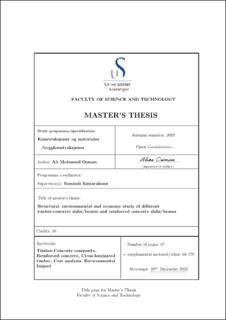| dc.contributor.advisor | Samarakoon, Samindi | |
| dc.contributor.author | Osman, Ali | |
| dc.date.accessioned | 2021-04-19T12:53:09Z | |
| dc.date.available | 2021-04-19T12:53:09Z | |
| dc.date.issued | 2020-12 | |
| dc.identifier.uri | https://hdl.handle.net/11250/2738393 | |
| dc.description | Master's thesis in structural engineering | en_US |
| dc.description.abstract | This thesis discusses two case studies, where case 1 is compared Timber-concrete composite (TCC) beam and Reinforced concrete beam (RC beam), while case 2 is compared Cross laminated timber (CLT) slab and Reinforced concrete slab (RC slab). Both cases are analyzed with respect to structural design, greenhouse gas emissions, and cost analysis. The effects of beam/slab span on design values, carbon dioxide emissions and cost are examined in terms of structural design, environmental impact and economy. Different span lengths are chosen for this purpose. The comparison shows that, the ability of TCC and CLT elements to store carbon is far greater than reinforced concrete elements, therefore, TCC and CLT elements have significantly lower carbon dioxide emissions and less impact on the climate. From economic point of view, reinforced concrete slab/beam are cheaper than TCC and CLT. But CLT and TCC element are competitive in the construction market because of their rapid production process which saves money for construction in longer run. The difference of material cost for TCC and reinforced concrete is less for shorter spans, but becomes greater as the span length is increased, the same applies between CLT and RC slab. On the other hand, the difference for cost of ready to assemble becomes narrower for TCC beam and reinforced concrete than CLT slab vs reinforced concrete slab are. This study shows that TCC and CLT elements can compete with concrete elements for long spans. Moment capacity is a critical factor for concrete slabs with shorter spans, while CLT experience difficulty to meet the design requirements of natural frequency for longer spans. The structural design for TCC beam can also compete with concrete beam with same cross section dimensions, natural frequency criterion is the main design issue for both beams with spans above 6m | en_US |
| dc.language.iso | eng | en_US |
| dc.publisher | University of stavanger, Norway | en_US |
| dc.relation.ispartofseries | Masteroppgave/UIS-TN-IMBM/2020; | |
| dc.rights | Navngivelse-Ikkekommersiell 4.0 Internasjonal | * |
| dc.rights.uri | http://creativecommons.org/licenses/by-nc/4.0/deed.no | * |
| dc.subject | Eurocode 2, Eurocode 5 | en_US |
| dc.subject | timber-concrete composite | en_US |
| dc.subject | cost analysis | en_US |
| dc.subject | crosslaminated timber | en_US |
| dc.subject | reinforced concrete | en_US |
| dc.title | Timber-concrete composite beam, Cross laminated timber slab and Reinforced concrete beam/slab; A comparative of two case study for structural design, environmental impact and economy. | en_US |
| dc.title.alternative | A Comparative study of Tow Case Studies;Beam:Timber-Concrete Composite VsReinforced Concrete Beam, CrossLaminated Timber Slab vs ReinforcedConcrete Slab | en_US |
| dc.type | Master thesis | en_US |
| dc.description.version | submittedVersion | en_US |
| dc.subject.nsi | VDP::Teknologi: 500 | en_US |

